Sarabande – from Suite no. 4 in D Minor, HWV 437 G.F. Händel (Piano solo sheet music)

Georg Friedrich Händel, the German composer who conquered England with Italian opera
His father, a court surgeon in Saxony, wanted the boy to be a lawyer. However, from very early on, he showed a great interest and predisposition for music and composition. Such was the insistence that, finally, he was allowed to study with the organist Friedrich Wilhelm Zachow, a prominent musician and teacher of the so-called German Baroque.
From there, the boy got to know and learn composition and musical genres, and the works of the greatest composers to date; without noticing that he himself would also become one of the most notable of his generation: Georg Friedrich Händel.
Born in the German city of Halle, on February 23, 1685, Händel began to compose his own work, whose influence from master musicians from different eras and regions was decisive. That is why, according to some biographers and critics, his religious music in particular took both German and Italian music as sources. For example, in his piece Silete venti (c. 1724).
He managed to be an expert in keyboard instruments, such as the clavichord and the organ; and he also learned to play the oboe and violin. At 17, he had already been appointed organist of Halle Cathedral: the same one where his own professor, Zachow, held the position.
However, the young musician felt that he had much more to learn and thus broaden his musical experience. He traveled to Hamburg and began working with the local opera orchestra. But his training did not end there: a profound admirer of opera, in 1706 he settled in Italy to continue his practice as a performer and composer. They quickly began to compare him to Domenico Scarlatti, one of the great harpsichordists of the time.
It was there, in Italy, when the court of Hannover hired him as a Kapellmeister to display all his musical work. This also allowed him to travel and exhibit the Italian operas that so fascinated him. And he did it in London, where Italian music was very fashionable . In fact, at the age of 34, the English aristocracy inaugurated a theater dedicated to the opera of beautiful Italy. Händel, amazed and not missing the opportunity, stayed much longer than required. The Hannover court dismissed him and he stayed in London, writing operas and broadcasting the best Italian pieces, among other compositions. There in England he was more than recognized and that is why he stayed for 48 years, until the end of his life. In 1727 he obtained British nationality .
His great passion was opera , those dramatic works to be represented through the virtuosity of lyrical singing, with instrumental accompaniment. However, as a musical language, Handel’s sensitivity and dramatic sense always took him further. He realized that serving only the voices on stage was not enough: the music also had to reach the audience , the sound also had to give the character a genuine psychological depth.
This can be seen in some of his operas such as Julius Caesar (1724), Orlando (1733) and Alcina (1735). Händel did not want a simple vocal virtuosity of the interpreters. So, he brings a greater richness to it with effects that try, above all, to move and move. In Julius Caesar , for example, he placed a second orchestra on stage, unusual at the time, to add more drama to the show itself. In his works, somehow, there is always that superior touch.
Please, subscribe to our Library.
If you are already a subscriber, please, check our NEW SCORES’ page every month for new sheet music. THANK YOU!
Water music, The Messiah and an English hymn
According to the German musicologist, Bernd Baselt, Handel’s musical output includes 612 works, plus 25 supplements and other adjudicated pieces of dubious authorship, and some lost. Among his compositions, Handel wrote operas, stage music, oratorios, serenades, odes, and a large number of cantatas.
One of his emblematic works is the hymn he composed for the coronation of the English King George II. Since then, it has been sung at every British coronation, including Elizabeth II’s . On the other hand, Händel received many jobs on request. For example, King George I had already commissioned works like the one he called Water Music (1717): a collection of orchestral movements to be performed during a boat party along the Thames, which the monarch performed with the court.
In some biographical texts, it is said that the financial stability of Handel —who suffered from obesity and other health problems— was subject to the success or otherwise of his works . Several times, things did not go well and he even was on the verge of going to jail on different occasions. Other times, he achieved notable success, such as when El Mesías was released . However, for this work, he never received a coin.
Regarding Messiah , perhaps the musician’s most famous work, the Spanish writer Jesús Callejo commented : “One afternoon on April 13, 1737, Handel’s servant, Christof Schmidt, found the corpulent musician lying on the floor in the London composer’s home. He had given him a stroke that nearly killed him.
That year he had written four operas, and day after day he was subjected to a lot of stress, great pressures that came from the divas, from the critics, in addition to the debts that he had to bear. They recommended that he take hot baths at the Aachen spa, and that undoubtedly helped his recovery ”.
And he added: “He recognized that that stage was like being in hell, from which he managed to get out safe and sound, and with the spirit of composing more operas and oratorios. He still had to put music to his masterpiece: Messiah , whose script came to him at another critical moment in his life. In 1740, in addition to the economic crisis, he was tormented by the creative crisis.
His company had gone bankrupt, and he was uncertain about the future. The last oratorios had been a failure, but when he began to read the text of the new work, he realized that he had to do it and as soon as possible: it only took three weeks, a record. Handel, once he had finished it, raised the score and said to his assistant: ‘It seemed to me that I had seen the face of God’”.
Messiah was a complete success and, as Callejo explains, it was one of the first times that 700 people came to enjoy the premiere in Dublin and, later, in London. Händel never charged money for this work and, by the way, he once expressed: “It will always be for the sick and for the prisoners, because I have been sick and with it I have been cured; I was a prisoner, and she set me free.”
With this piece, Handel reached his peak with opera. From that moment, he did not return to produce the genre to return to the oratorios. This dramatic musical genre, unlike opera and usually with a religious overtone, is carried out without scenery, costumes, or decorations.
With them, once again, the German composer demonstrated his skill and cosmopolitan spirit, because he did not hesitate at all to write in English on texts that go back to the long Lutheran musical tradition (the liturgical tradition of Germany), in which he also integrates Italian modern writing. That is why many specialists maintain that, in reality, Händel never managed to detach himself from the opera in its entirety.
These oratorios were phenomenally successful in England. And such was the recognition that English society made Händel its national composer . That is why, whenever a historical event was held on British soil, Händel was the one to compose the music for those official meetings.
The goodbye of a genius and the birth of a legend
Due to cataract problems, in 1752 he decided to undergo surgery with John Taylor, the same surgeon who had already surgically treated the other great musician of the time, Johann Sebastian Bach. However, Händel had the worst experience: he went blind from the bad surgery and never composed a piece again. Seven years later, he died on April 14, 1759, at his London home, aged 74 .
Experts say that with Händel (and also with Bach), he concluded a period that knew how to dazzle the world with virtuosity, beauty and passion, starting with the appearance of genres such as opera, sonata and concert. However, still today, in the successive performances of contemporary disciples and admiring musicians, those golden chords that marked that entire era in the history of universal music resound.
Best Sheet Music download from our Library.
Browse in the Library:
| Artist or Composer / Score name | Cover | List of Contents |
|---|---|---|
| Astor Piazzola Oblivion Guitar Arr. By Nadja Kossinskaja |
 |
Piazzola Oblivion Guitar arr. by Nadja Kossinskaja page 1-1 |
| Astor Piazzolla 12 Tangos Piano |
 |
|
| Astor Piazzolla 6 Tangos |
 |
Astor Piazzolla 6 Tangos |
| Astor Piazzolla Angel (Complete) For Piano (Different Version) |
 |
Astor Piazzolla Angel (Complete) For Piano (Different Version) |
| Astor Piazzolla Ave Maria (Piano) |
 |
|
| Astor Piazzolla Balada Para Un Loco (Cacho Tirao) Guitar |
 |
|
| Astor Piazzolla Maria De Buenos Aires, Opera Tango (Partitura completa) |
 |
|
| Astor Piazzolla Milonga Del Angel (Piano Solo) Arranged By Prof. John Mortensen Slow Tango |
 |
|
| Astor Piazzolla Milonga Del Angel (Piano Solo) Original |
 |
|
| Astor Piazzolla sheet music Le Grand Tango Score For Viola And Piano |
 |
|
| Astor Piazzolla Vuelvo al sur (piano) |
 |
|
| Astor Piazzolla – 5 piezas para guitarra (guitar sheet music) | Astor Piazzolla – 5 piezas para guitarra (guitar sheet music) | |
| Astor Piazzolla – Picasso (Tango) Piano |
 |
|
| Astor Piazzolla 4 Estaciones Porteñas Guitar arr. |
 |
|
| Astor Piazzolla Nightclub 1960 Duo Flute Guitar |
 |
|
| Astor Piazzolla – Adios Nonino (Two Pianos) | Astor Piazzolla – Adios Nonino (Two Pianos) | |
| Astor Piazzolla – Adiós Nonino (guitar sheet music) |
 |
|
| Astor Piazzolla – Adios Nonino Piano Solo |
 |
|
| Astor Piazzolla – Album No. 1 |
 |
Astor Piazzolla album no 1 |
| Astor Piazzolla – Album No. 2 |
 |
Astor Piazzolla – Album No. 2 |
| Astor Piazzolla – Album No. 4 |
 |
Astor Piazzolla – Album No. 4 |
| Astor Piazzolla – Buenos Aires Hora Cero | Astor Piazzolla – Buenos Aires Hora Cero | |
| Astor Piazzolla – Chau Paris (piano) | Astor Piazzolla – Chau Paris (piano) | |
| Astor Piazzolla – Complete Works – Obras Para Piano Y Varios Instrumentos (partituras, sheet music) | Astor Piazzolla – Complete Works – Obras Para Piano Y Varios Instrumentos (partituras, sheet music) | |
| Astor Piazzolla – Contrastes (Piano) | Astor Piazzolla – Contrastes (Piano) | |
| Astor Piazzolla – Coral (Piano) | Astor Piazzolla – Coral (Piano) | |
| Astor Piazzolla – Estaciones Porteñas for piano – für Klavier |
 |
Astor Piazzolla – Estaciones Portenas fur Klavier |
| Astor Piazzolla – Fuga 9 (Piano) | Astor Piazzolla – Fuga 9 (Piano) | |
| Astor Piazzolla – Invierno Porteno (guitar sheet music) |
 |
|
| Astor Piazzolla – Invierno porteño [clarinet-piano] |
 |
|
| Astor Piazzolla – La Muerte Del Angel (Guitar arr. sheet music) |
 |
|
| Astor Piazzolla – Libertango (Part A – Guitar Arr.) (Musescore File).mscz | ||
| Astor Piazzolla – Libertango for 2 pianos | Astor Piazzolla – Libertango 2KL | |
| Astor Piazzolla – Los pajaros perdidos (canción) piano vocal |
 |
|
| Astor Piazzolla – Milonga Del Angel (guitar arr. sheet music) |
 |
|
| Astor Piazzolla – Milonga del angel (Piano solo) |
 |
Astor Piazzolla – Milonga del angel |
| Astor Piazzolla – Oblivion (piano solo ver.) | Astor Piazzolla – Oblivion (piano solo sheet music) | |
| Astor Piazzolla – Oblivion (piano solo) |
 |
|
| Astor Piazzolla – Oblivion arr. by Najda Kssinskaja (Guitar arr. sheet music with TABs) | Astor Piazzolla – Oblivion arr. by Najda Kssinskaja (Guitar arr. sheet music with TABs) | |
| Astor Piazzolla – Oblivion Cello & piano | Piazzolla Oblivion cello piano arr. | |
| Astor Piazzolla – Oblivion for Piano solo sheet music (partitura) |
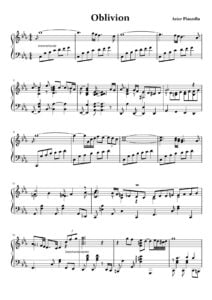 |
|
| Astor Piazzolla – Onda Nueve (Tango) Piano | Astor Piazzolla – Onda Nueve (Tango) Piano | |
| Astor Piazzolla – Otoño Porteño (guitar sheet music) | Astor Piazzolla – Otoño Porteño (guitar sheet music) | |
| Astor Piazzolla – Piano SongBook (Angel, Libertango, 6 Tangos, Estaciones Porteñas) |
 |
|
| Astor Piazzolla – Preludio 9 (Piano) | Astor Piazzolla – Preludio 9 (Piano) | |
| Astor Piazzolla – Río Sena (Tango) Piano | Astor Piazzolla – Río Sena (Tango) Piano | |
| Astor Piazzolla – Romanza del Duende (Piano) | Astor Piazzolla – Romanza del Duende (Piano) | |
| Astor Piazzolla – sheet music – Suite del Angel (Piano) |
 |
|
| Astor Piazzolla – Soledad (Solitude) Full score sheet music | Astor Piazzolla – Soledad (Solitude) Full score sheet music (first page) | |
| Astor Piazzolla – Suite Troileana 2 guitars (Bandoneon, Zita, Whisky, Escolaso) |
 |
|
| Astor Piazzolla – Suite Troileana 2 guitars arr. Sergio Assad (Bandoneon, Zita, Whisky, Escolaso) |
 |
|
| Astor Piazzolla – Suite Troileana arr for Piano (Bandoneon, Zita, Whisky, Escolaso) |
 |
|
| Astor Piazzolla – Tangos for 2 Pianos |
 |
Astor Piazzolla – Tangos for 2 Pianos |
| Astor Piazzolla – Tangus Dei (Piano) |
 |
|
| Astor Piazzolla – The Last Tango Music Of Guitar arr. |
 |
|
| Astor Piazzolla – Tristango (Piano) | Astor Piazzolla – Tristango (Piano) | |
| Astor Piazzolla – Vuelvo Al Sur (10 tangos and other pieces arr. piano) |
 |
Astor Piazzolla – Vuelvo Al Sur |
| Astor Piazzolla -Four, For Tango – Score |
 |
|
| Astor Piazzolla (Spanish Español Ed. 2018 El Ateneo 2020) (María Susana Azzi) Biography Book |
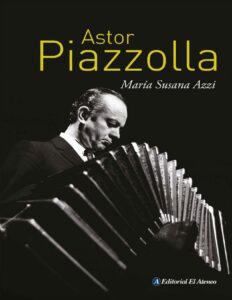 |
|
| Astor Piazzolla (Tango) Balada Para Un Loco – Guitar (letra Horacio Ferrer) |
 |
|
| Astor Piazzolla 100 Años Edicion Aniversario Sus mejores obras para piano |
 |
Astor Piazzolla 100 Años Edicion Aniversario Sus mejore obras para piano |
| Astor Piazzolla 25 Tangos for Clarinet and piano Clarinet Part in Bb |
 |
Astor Piazzolla 25 Tangos for Clarinet and piano Clarinet Part in Bb |
| Astor Piazzolla 28 tangos arranged For Piano |
 |
Astor Piazzolla 28 tangos arranged For Piano |
| Astor Piazzolla Album 20 compositions arr. for Piano |
 |
Piazzolla album |
| Astor Piazzolla Ave Maria (Piano and voice) |
 |
|
| Astor Piazzolla Cinco Piezas For Guitar |
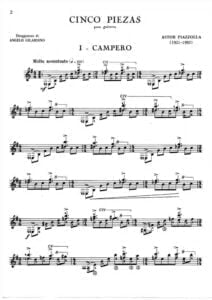 |
|
| Astor Piazzolla Color de Buenos Aires Suite letra Horacio Ferrer |
 |
|
| Astor Piazzolla Contrabajeando Double Bass And Piano Contrabajo Y Piano |
 |
|
| Astor Piazzolla Extasis Piano (Tango) |
 |
|
| Astor Piazzolla Flute or Violin Piano Collection |
 |
|
| Astor Piazzolla For Violin And Guitar (Astor Piazzolla) |
 |
Astor Piazzolla For Violin And Guitar (Astor Piazzolla)_compressed |
| Astor Piazzolla Guitar compositions Collection (Guitarra) sheet music, partituras | Astor Piazzolla Guitar compositions (Guitarra) sheet music, partituras | |
| Astor Piazzolla Horacio Ferrer Chiquilin De Bachin Piano vocal |
 |
|
| Astor Piazzolla La Muerte Del Angel Trio Violin Cello Piano Score |
 |
|
| Astor Piazzolla Le Grand Tango – Two Pianos | Astor Piazzolla Le Gran Tango – Two Pianos | |
| Astor Piazzolla Libertango (Guitar Solo Arr.) With Tab |
 |
|
| Astor Piazzolla Milonga Del Àngel (For Chamber Orchestra) Tangos |
 |
|
| Astor Piazzolla Oblivion (piano solo) |
 |
|
| Astor Piazzolla Oblivion arr. for 2 violins |
 |
|
| Astor Piazzolla Oblivion for Violin or Flute Cello Piano | Astor Piazzolla Oblivion for Violin or Flute Cello Piano | |
| Astor Piazzolla Oblivion Trans Solo Piano | Astor Piazzolla Oblivion Trans Solo Piano sheet music pdf | |
| Astor Piazzolla Oblivion Violin Guitar |
 |
|
| Astor Piazzolla Obras Completas Guitarra For Guitar |
 |
Astor Piazzolla Obras Completas For Guitar |
| Astor Piazzolla Piano Collection |
 |
Astor Piazzolla Piano Collection |
| Astor Piazzolla Piano Meditango |
 |
|
| Astor Piazzolla Romance Del Diablo Flauta Violin and Piano |
 |
|
| Astor Piazzolla Sensuel Piano |
 |
|
| Astor Piazzolla Tangazo for Orchestra Variaciones sobre Buenos Aires para orquestra |
 |
|
| Astor Piazzolla Tango Etudes (for flute or Violin) | Astor Piazzolla Tango Etudes (for flute or Violin) | |
| Astor Piazzolla Tango S V P For Violin Ensemble Solo | Astor Piazzolla Tango S V P For Violin Ensemble Solo | |
| Astor Piazzolla Tangos Arr Phillip Keveren The Phillip Keveren Series Piano Solo |
 |
Astor Piazzolla Tangos Arr Phillip Keveren The Phillip Keveren Series Piano Solo |
| Astor Piazzolla Tanti Anni Prima Ave Maria For Piano solo |
 |
|
| Astor Piazzolla Tanti Anni Prima Ave Maria Violin and Piano |
 |
|
| Astor Piazzolla Vuelvo Al Sur Flute or Violin and Piano | Astor Piazzolla Vuelvo Al Sur Flute or Violin and Piano | |
| Astor Piazzolla y Anibal Troilo- Contrabajeando (Tango) Piano | Astor Piazzolla y Anibal Troilo- Contrabajeando (Tango) Piano | |
| Atlantic Starr – Always | ||
| Atomic Kitten – The Tide Is High | ||
| Atomic The Musical By Philip Foxman And Danny Ginges Piano Vocal Score |
 |
|
| Atonement – Dario Marianelli (For Piano) |
 |
Atonement – Dario Marianelli (For Piano) |
| Au Clair De La Lune – Traditional (Musescore File).mscz | ||
| Audioslave Out Of Exile Guitar TABs |
 |
Audioslave Out Of Exile Guitar TABs |
| Audition (The Fools who Dream) La La Land OST | ||
| Audra Mcdonald Build A Bridge (Songbook) (Audra Mcdonald) Piano Vocal Guitar chords |
 |
Audra Mcdonald Build A Bridge (Songbook) (Audra Mcdonald) Piano Vocal Guitar chords |
| Augustana – Boston | ||
| Aura Lee (intermediate great jazz arrangement) G. Poulton | Aura Lee Jazz | |
| Aura Lee By G. Poulton Jazz Arrangement.mxl | ||
| Aura Lee G. Poulton (Easy version ) | Aura Lee Easy version | |
| Aura Lee Jazz (Musescore File).mscz | ||
| AURORA Conqueror Piano Solo arr. |
 |
|
| AURORA Running With The Wolves |
 |
|
| Aurora – Cure For Me |
 |
|
| AURORA Forgotten Love Piano with lyrics |
 |
|
| AURORA Half The World Away Sheet Music Piano Vocal Guitar chords |
 |
|
| AURORA Into The Unknown from Disney’s Frozen |
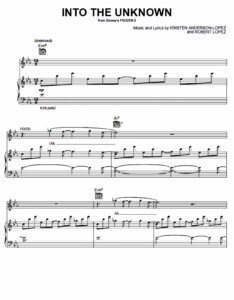 |
|
| AURORA It Happened Quiet Piano Solo arr. |
 |
|
| AURORA Runaway Piano Vocal guitar Chords |
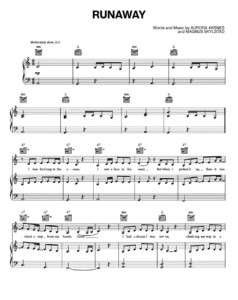 |
|
| AURORA Songbook Sheet Music Anthology Collection | AURORA Songbook Sheet Music Anthology Collection | |
| AURORA The River Aurora Piano Solo arr. |
 |
|
| Automatic Harmonic Analysis of Jazz Chord Progressions Using a Musical Categorial Grammar (Mark Wilding) | Automatic Harmonic | |
| Autour Du Jazz Guitar 4 pièces pour guitare (Thierry Tisserand) |
 |
Autour Du Jazz Guitar 4 pièces pour guitare (Thierry Tisserand) Contents — autour du jazz |
